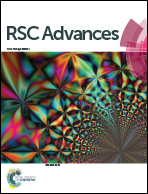Alkali and alkaline-earth metal complexes with tetraoxa[8]circulene sheet: a computational study by DFT and QTAIM methods†
Abstract
A series of alkali and alkaline-earth metal ion complexes with the tetraoxa[8]circulene sheet which possess single- and double-decker structure has been designed and studied by the DFT computational method. Bader's topological analysis of the electron density distribution function has been also performed for the studied complexes with the aim to determine their peculiar electronic features. The obtained computational results indicate the definite selectivity in respect to complexation of the s-block metal ions with the tetraoxa[8]circulene-formed nanopores of various sizes. The coordination bonds of the s-block metal centers with the neighbouring oxygen atoms in the studied complexes possess predominantly ionic nature and can be interpreted as low-covalence closed-shell interactions. The total complexation energy for the studied systems has been estimated to be in a wide range of 9–60 kcal mol−1 which indicates their different stability depending on the nanopore size and metal ion radii. For these reasons the synthesis of the tetraoxa[8]circulene sheets is an important task because of their potential applications as biomimetic-type nanopores representing synthetic ionic channels.
![Graphical abstract: Alkali and alkaline-earth metal complexes with tetraoxa[8]circulene sheet: a computational study by DFT and QTAIM methods](/en/Image/Get?imageInfo.ImageType=GA&imageInfo.ImageIdentifier.ManuscriptID=C4RA13806F&imageInfo.ImageIdentifier.Year=2015)

 Please wait while we load your content...
Please wait while we load your content...